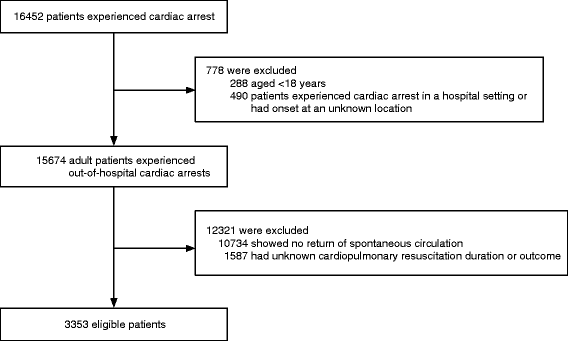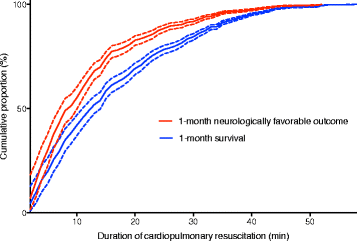Association between cardiopulmonary resuscitation duration and one-month neurological outcomes for out-of-hospital cardiac arrest: a prospective cohort study
- PMID: 28431508
- PMCID: PMC5401557
- DOI: 10.1186/s12871-017-0351-1
Association between cardiopulmonary resuscitation duration and one-month neurological outcomes for out-of-hospital cardiac arrest: a prospective cohort study
Abstract
Background: The duration of cardiopulmonary resuscitation (CPR) is an important factor associated with the outcomes for an out-of-hospital cardiac arrest. However, the appropriate CPR duration remains unclear considering pre- and in-hospital settings. The present study aimed to evaluate the relationship between the CPR duration (including both the pre- and in-hospital duration) and neurologically favorable outcomes 1-month after cardiac arrest.
Methods: Data were utilized from a prospective multi-center cohort study of out-of-hospital cardiac arrest patients transported to 67 emergency hospitals between January 2012 and March 2013 in the Kanto area of Japan. A total of 3,353 patients with out-of-hospital cardiac arrest (age ≥18 years) who underwent CPR by emergency medical service personnel and achieved the return of spontaneous circulation in a pre- or in-hospital setting were analyzed. The primary outcome was a 1-month favorable neurological outcome. Logistic regression analysis was performed to estimate the influence of cardiopulmonary resuscitation duration. The CPR duration that achieved a cumulative proportion >99% of cases with a 1-month neurologically favorable outcome was determined.
Results: Of the 3,353 eligible cases, pre-hospital return of spontaneous circulation was obtained in 1,692 cases (50.5%). A total of 279 (8.3%) cases had a 1-month neurologically favorable outcome. The CPR duration was significantly and inversely associated with 1-month neurologically favorable outcomes with adjustment for pre- and in-hospital confounders (adjusted odds ratio: 0.911, per minute, 95% CI: 0.892-0.929, p < 0.001). After 30 min of CPR, the probability of a 1-month neurologically favorable outcome decreased from 8.3 to 0.7%. At 45 min of CPR, the cumulative proportion for a 1-month neurologically favorable outcome reached >99%.
Conclusions: The CPR duration was independently and inversely associated with 1-month neurologically favorable outcomes after out-of-hospital cardiac arrest. The CPR duration required to achieve return of spontaneous circulation in >99% of out-of-hospital cardiac arrest patients with a 1-month favorable neurological outcome was 45 min, considering both pre- and in-hospital settings.
Keywords: Cardiopulmonary resuscitation; Emergency medical services; Out-of-hospital cardiac arrest; Patient outcome assessment.
Figures



Similar articles
-
Impact of cardiopulmonary resuscitation duration on neurologically favourable outcome after out-of-hospital cardiac arrest: A population-based study in Japan.Resuscitation. 2017 Apr;113:1-7. doi: 10.1016/j.resuscitation.2017.01.005. Epub 2017 Jan 18. Resuscitation. 2017. PMID: 28109995
-
Relationship Between the Duration of Cardiopulmonary Resuscitation and Favorable Neurological Outcomes After Out-of-Hospital Cardiac Arrest: A Prospective, Nationwide, Population-Based Cohort Study.J Am Heart Assoc. 2016 Mar 18;5(3):e002819. doi: 10.1161/JAHA.115.002819. J Am Heart Assoc. 2016. PMID: 26994129 Free PMC article.
-
Duration of Prehospital Cardiopulmonary Resuscitation and Favorable Neurological Outcomes for Pediatric Out-of-Hospital Cardiac Arrests: A Nationwide, Population-Based Cohort Study.Circulation. 2016 Dec 20;134(25):2046-2059. doi: 10.1161/CIRCULATIONAHA.116.023821. Epub 2016 Oct 24. Circulation. 2016. PMID: 27777278
-
Survival outcome among patients with out-of-hospital cardiac arrest who received cardiopulmonary resuscitation in China: a systematic review and meta-analysis.Eur J Med Res. 2023 Jan 4;28(1):8. doi: 10.1186/s40001-022-00955-x. Eur J Med Res. 2023. PMID: 36600249 Free PMC article.
-
Chest-compression-only versus conventional cardiopulmonary resuscitation by bystanders for children with out-of-hospital cardiac arrest: A systematic review and meta-analysis.Resuscitation. 2019 Jan;134:81-90. doi: 10.1016/j.resuscitation.2018.10.032. Epub 2018 Nov 2. Resuscitation. 2019. PMID: 30391520
Cited by
-
Comparison of hemodynamic effects and resuscitation outcomes between automatic simultaneous sterno-thoracic cardiopulmonary resuscitation device and LUCAS in a swine model of cardiac arrest.PLoS One. 2019 Aug 30;14(8):e0221965. doi: 10.1371/journal.pone.0221965. eCollection 2019. PLoS One. 2019. PMID: 31469891 Free PMC article.
-
The association between arrival potassium and 30-day survival following resuscitation from out-of-hospital cardiac arrest: a retrospective cohort study.Scand J Trauma Resusc Emerg Med. 2025 Aug 26;33(1):144. doi: 10.1186/s13049-025-01454-8. Scand J Trauma Resusc Emerg Med. 2025. PMID: 40859315 Free PMC article.
-
Randomised simulation trial found an association between rescuers' height and weight and chest compression quality during paediatric resuscitation.Acta Paediatr. 2020 Sep;109(9):1831-1837. doi: 10.1111/apa.15229. Epub 2020 Mar 3. Acta Paediatr. 2020. PMID: 32053243 Free PMC article.
-
Effects of Prehospital Factors on Survival of Out-Of-Hospital Cardiac Arrest Patients: Age-Dependent Patterns.Int J Environ Res Public Health. 2020 Jul 29;17(15):5481. doi: 10.3390/ijerph17155481. Int J Environ Res Public Health. 2020. PMID: 32751367 Free PMC article.
-
Impact of cardiopulmonary resuscitation duration on the neurological outcomes of out-of-hospital cardiac arrest.Int J Emerg Med. 2022 Mar 19;15(1):12. doi: 10.1186/s12245-022-00418-4. Int J Emerg Med. 2022. PMID: 35305561 Free PMC article.
References
-
- Chen YS, Lin JW, Yu HY, Ko WJ, Jerng JS, Chang WT, et al. Cardiopulmonary resuscitation with assisted extracorporeal life-support versus conventional cardiopulmonary resuscitation in adults with in-hospital cardiac arrest: an observational study and propensity analysis. Lancet. 2008;372:554–61. doi: 10.1016/S0140-6736(08)60958-7. - DOI - PubMed
-
- Goto Y, Funada A, Goto Y. Relationship between the duration of cardiopulmonary resuscitation and favorable neurological outcomes after out-of-hospital cardiac arrest: a prospective, nationwide, population-based cohort study. J Am Heart Assoc. 2016;4:e002819. doi: 10.1161/JAHA.115.002819. - DOI - PMC - PubMed
Publication types
MeSH terms
LinkOut - more resources
Full Text Sources
Other Literature Sources
Medical

